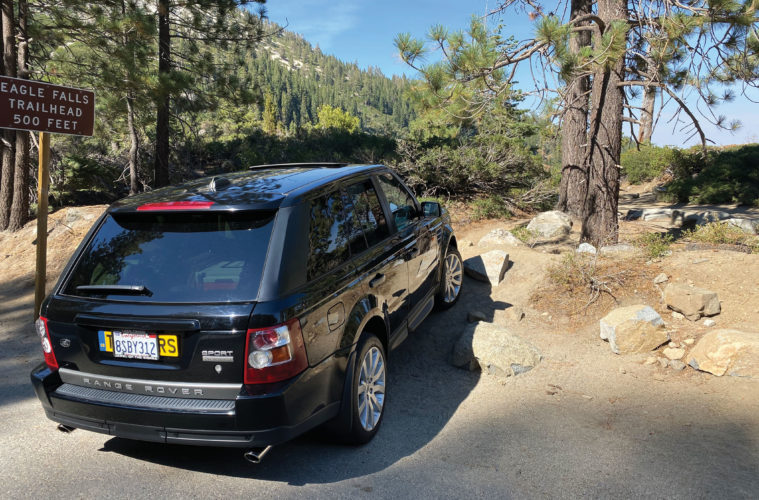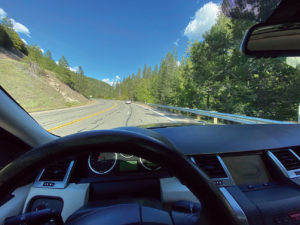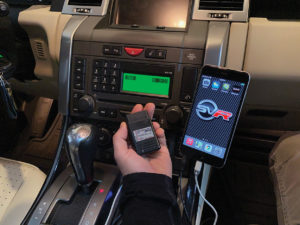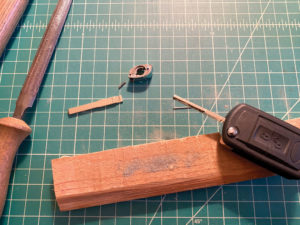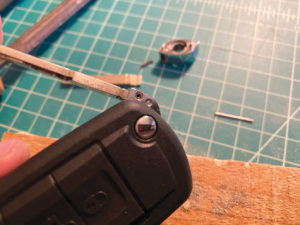I love to drive — off-road, on narrow, winding roads and straight highways, rallying, track days and hill climbs. From my Dad’s ’69 Porsche 911E to my ’80 Chevy LUV 4×4 to my ’94 NAS Defender 90, through my multiple Porsches, Audis and MINI, I live for the drive.
With my return to my native California in 2019, my driving needs and experiences changed along with my environment. Twenty-four years in Vermont had enforced the need for winter traction and concern about corrosion due to salted roads. As I’m now living in the mountains of Lake Tahoe, with an average snowfall total of 18 feet, traction still matters — but when I descend to lower elevations the snow disappears and I can enjoy speed and lots of power.
A small, two-car garage — one bay taken up by our ’12 Audi A4 Avant Sport — and a 10 ft. driveway at our new house meant I had to find one Land Rover that would fit and fulfill all of my on-road/off-road needs. (Sadly, it could not be a Bowler EXR rally-raid competition car!)
In 2004, the Land Rover UK design team dropped its first-ever concept vehicle at the NAIAS Detroit Auto Show — the Range Stormer, a wild, three-door coupé in striking Vesuvius Orange. It sported stunning looks — see the split-folding gullwing doors — and the perfect combination of four-wheel-drive with a promised 180 mph top speed. Designed under the leadership of Richard Wolley, the Range Stormer took Land Rover in a totally different direction and broadened the Range Rover family. [See Holiday 2020 Issue —ed.]
As a concept vehicle I found it brilliant; it hit all the right notes. Land Rover used the Range Stormer concept to raise excitement about the Range Rover Sport. It would compete against the BMW X5 and Porsche Cayenne. The new Range Rover Sport (L320) came stateside with new Jaguar AJ-V8 engines; 4.2L supercharged (390PS/550Nm) and 4.4L normally aspirated (300PS/425Nm) units.
With my past Porsche time trialing, autocrossing, and Audi quattro hillclimb/racing experience, the Sport with the 4.2L V8 supercharged engine, dynamic suspension handling and huge Brembo front brake stopping power intrigued me the most — plus it has legendary Land Rover off-road capability. This is the Land Rover for a proper racing and rallying enthusiast!
The opportunity to buy a Land Rover in dry Northern California (rather than salty Vermont) would be a wise choice. Immediately, I started looking for a 2006–2009 Range Rover Sport 4.2L Supercharged with its Brembo brakes. Most enthusiasts recommended the HSE model, but it came without Dynamic Response suspension (hydraulically adjustable sway bars) — one of the features that makes the Supercharged edition handle so well on-road. For off-roading, at low speeds, it turns off automatically with Terrain Response. This choice would serve my needs well at 6,500 ft elevation, with its ability to raise the suspension to tackle deep snow and lower it for mountain roads in the summer.
My requirements were: a purchase price budget of $10,000, a mileage limit of 100,000, one of two exterior colors (Rimini Red or Java Black), and an interior of Ivory leather. Oh yes, due to pandemic restrictions, the Range Rover had to be within a few hours of my house. Even with California’s 16 million vehicles, I found the search challenging.
After two months of scouring many online sources, I finally found one that met my conditions — a 2007 Java Black/Ivory interior Range Rover Sport Supercharged. It was totally clean, showed no hard use and CarFax records hinted at solid servicing. (CarFax does not provide a full service history, but it gives enough information for the enthusiast to become an automotive detective.) As soon as I saw it that evening, I feared that it would disappear if I did not return the next morning to buy it.
Most everything on the Sport looked in order — its clean condition blew me away — and it drove very well on the test drive. The front lower control arm bushings (a 100,000 mile service recommendation) looked new. The driving experience indicated a well-maintained Range Rover. More importantly, the undercarriage reflected a 13-year life in the dry NorCal climate.
After the test drive, I knew I wanted it, but I confronted a few minor issues. There was a warning of “low coolant level” when starting the engine, but coolant level was normal, and after the test drive, I found no coolant leaks. It came with only one new factory key fob with an original cut key part only, no second fob. The one Land Rover genuine key fob’s remote buttons didn’t work, and this independent dealer didn’t have any luck making the remote function. I felt I could tackle these issues and we came to an agreed price.
Suddenly, I owned a 13-year-old Range Rover Sport Supercharged, with its independent Dynamic Response suspension system and more complex electronics — what did I get myself into? Nothing like my former ‘94 NAS Defender 90! But, the drive back up to Lake Tahoe confirmed that this Sport really had 390 hp and was well up to the task of spirited tarmac driving sessions. The handling impressed me for such a heavy (5,468 lb) vehicle. It had exceptionally flat cornering through the twisty tarmac turns on Hwy 50 up and over Echo Summit. Its driving characteristics, enhanced by its shorter wheelbase, reminded me of my beloved 2006 MINI Cooper S. I was chuffed that this Sport had become the latest member of my automotive family.
I failed to follow the basic rule of purchasing a used Land Rover – research the service history before you buy! Returning to the CarFax, I sought out the service record from Stewart’s Automotive, Sacramento, CA. Over the phone, General Manager Matthew McCormick proved extremely helpful, noting they had serviced this Sport for a while and confirming its attentive care. One upcoming service issue would be a weeping supercharger intercooler radiator. I’ve always worked on my own vehicles, repairing transmissions, clutches, brakes, cooling, engines and electrical systems. It’s satisfying to know how to fix something right yourself. [See Spring 2021 issue for tech article on this repair —ed.]
New Tools
The first tool for a new Range Rover Sport owner should be a computer diagnostic unit. I reached out to Rovers North for a DIY solution — they pointed me toward the Gap-Diagnostic IIDTool BT. This tool would allow me to reset suspension faults, adjust EAS (Electronic Air Suspension) ride height, diagnose check engine lights, reset codes, etc. and would enable me to program the Land Rover key fob.
Service Information
The next step was to order “Manuals on USB” (part# LTP3015USB) with shop and owner’s manuals that cover the 2005–2009 Range Rover Sport. (For ease of access on my phone or other devices, I downloaded all the workshop manuals and technical information PDFs pertaining to my 2007 Range Rover Sport VIN on Land Rover Topix: https://topix.landrover.jlrext.com/topix/vehicle/lookupForm. )
Land Rover Genuine Accessories and Other Bits
I ordered several genuine accessories from Rovers North: mud flaps, a trailer hitch receiver, rubber floor mats and cup holder fillers. Online, I found I could order a personalized rear UK plate. This is the real deal, clear Perspex with reflective yellow background, customized lettering and spacing to fit behind the new California plate.
Side Lamp Bulb Replacement
Another quick repair was to replace a blown-out, driver’s front side lamp bulb. This is a small 12V 5W clear bulb that illuminates when the parking headlamps are on. A simple fix, you first remove the headlamp assembly. Lift up two tabs on the backside, wiggle the assembly loose, then disconnect the wiring harnesses and remove the assembly. Looking from the headlamp backside underneath, the bulb is shown as #2 in the parts illustration (left), part# RNS892.
Key Fob Functions
Next step was to program the key fob with the IIDTool BT; while successful in programming, it didn’t make the remote buttons work. I reached out to the Land Rover Scarborough, Maine service department and they shared a likely problem — a corroded and/or broken wire connection under the passenger side sill (right door). It splits off and delivers 12v power up the B-Pillar to the key fob receiver located underneath the headliner. (This should be the same for LR3s.) I removed the interior plastic trim in the B-Pillar, cowl side and scuff plate trim. After some rummaging through the wiring loom I found the culprit! There was a factory-installed red wire crimped part that had obviously deteriorated due to vibrations and/or possibly to moisture ingress. The wiring loom, door sill metal and everything around looked dry as ever; I’m baffled as to why only this part corroded. I made a quick snip of the wires, soldered a new piece of similar gauge wire back in and buttoned it all up with heat-shrink tubing. The first moment I tried the original key fob and my new replica fob, both remotes worked!
Conclusion
I’m delighted with my early (2006–2009) L320 Range Rover Sport and I hope my experiences inspire other enthusiasts. They’re brilliant drivers, on-road and off-road, and as I’m discovering, can be largely maintained and repaired at your home. The Range Rover Sport represents the most popular model in the Land Rover lineup. With 65,933 early L320s sold in the US (3,472 in Canada), you’re bound to find a good one for yourself.
Second Key Fob
My search for information on “key fobs not working” resulted in a wide range of recommendations. The easy one was to call a local Land Rover dealer and order a new key fob. In May 2020, I was told that due to Covid work restrictions in the UK, key fob replacements were on a national backorder! I searched on eBay to find a used fob or replica. I needed to find a fob that had an uncut key with 315mHz frequency and an ID46 (PCF7941chip) transponder chip. I received this and started on the fix by knocking out the very small pin holding the blank key using a watch strap pin. The new replica key fob was a tick smaller and required a bit of filing on the original cut key. While the replica key fob works to start the engine, lock and unlock the Sport remotely, it shows in the IIDTool BT that a “non-factory recognized key” was used. It’s our spare key so I can live with this until I can get a proper factory key fob replacement My recommendation would be to always get a Land Rover genuine part key fob and have it programed at your local dealer.
